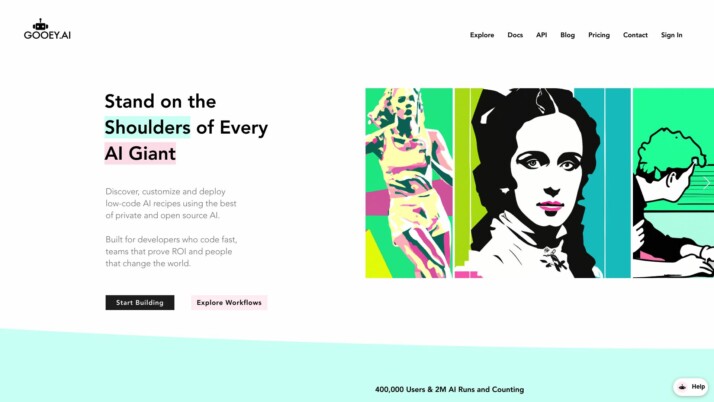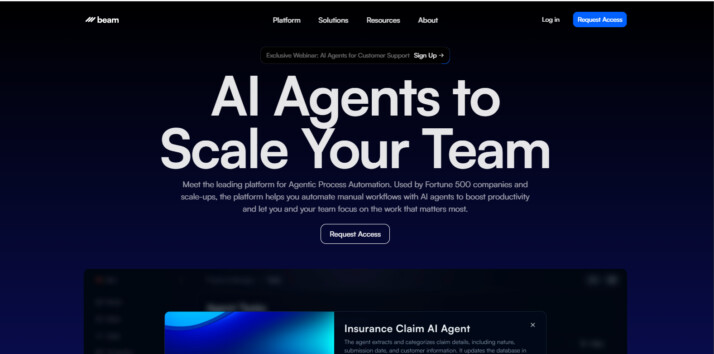Gooey AI vs. Beam AI: Comparing AI Agent Platforms
AI-powered tools are reshaping how businesses operate, automating tasks and enhancing productivity. Gooey AI vs. Beam AI stand out in this competitive field, each offering unique approaches to AI agent development. Gooey AI excels in creating sophisticated chatbots and AI copilots without extensive coding, while Beam AI focuses on process automation with adaptive AI agents. This comparison delves into their features, strengths, and limitations, exploring how they stack up against SmythOS, our comprehensive AI development platform. Whether you’re a developer seeking powerful API integrations, a business leader looking for scalable AI solutions, or a non-technical professional interested in no-code AI tools, this analysis will help you navigate the landscape of AI agent platforms and choose the solution that best fits your needs.
Gooey AI Overview
Gooey AI empowers users to create sophisticated AI copilots and chatbots without extensive coding knowledge. The platform integrates multiple large language models, including OpenAI’s GPT-3.5 and GPT-4, Google’s PaLM2, and others, to deliver versatile conversational abilities. Gooey AI stands out by combining both proprietary and open-source AI models, enabling highly customized solutions for various industries.
The platform’s no-code interface simplifies the development of AI copilots, making advanced AI accessible to fast-moving teams and organizations seeking to boost productivity and information accessibility. Gooey AI’s copilots can maintain context, leveraging memory capabilities to provide relevant responses based on conversation history. The platform also supports multimodal inputs, including text, audio, and video, expanding the range of possible applications.


Gooey AI empowers users to create sophisticated AI copilots and chatbots without extensive coding knowledge… enabling highly customized solutions for various industries.
Gooey AI excels in Retrieval Augmented Generation (RAG), enhancing AI responses with domain-specific knowledge from indexed documents. This feature significantly improves the accuracy and relevance of information provided by AI agents. Additionally, the platform offers synthetic data extraction capabilities, transforming videos and PDFs into editable formats and generating FAQs with citations, which greatly enhances search functionality and information retrieval.
While Gooey AI offers powerful features, users should consider potential limitations. The platform may require a learning curve to fully utilize its capabilities, especially for those new to AI development. Additionally, as with any AI solution, the quality of outputs depends on the quality of input data and proper configuration. Organizations must also ensure they have the necessary resources to maintain and update their AI copilots regularly for optimal performance.
Gooey AI’s vision centers on creating measurable value through AI workflows and chatbots, aiming to enhance productivity, unlock knowledge, and assist users in accomplishing tasks via conversational interfaces. By democratizing AI development, Gooey AI positions itself as a key player in the AI chatbot and automation market, catering to a wide range of applications from agriculture to customer support.
Beam AI Overview
Beam AI develops generative AI agents to automate repetitive manual tasks for organizations. Their Agentic Process Automations (APAs) perform tasks like data extraction, customer inquiry management, and order processing more efficiently than humans. These agents continuously learn and adapt, improving their precision over time.


Beam AI develops generative AI agents to automate repetitive manual tasks for organizations. Their Agentic Process Automations (APAs) perform tasks … more efficiently than humans.
Beam AI’s platform enables creating AI agents without extensive coding. The no-code UI allows building AI copilots and workflows accessible to non-technical users. Agents can maintain context, have memory capabilities, and collaborate to tackle complex tasks. The system supports multimodal inputs including text, audio, and video.
Beam AI emphasizes sustainability and speed in their automation solutions. The platform integrates with popular AI models like OpenAI GPT and Google PaLM. It offers features for deploying agents as APIs, webhooks, and scheduled tasks. Analytics and monitoring tools provide insights into agent performance.
While Beam AI offers powerful automation capabilities, it may have limitations in areas like visual programming interfaces and debugging tools compared to some competitors. The platform seems geared more toward business process automation than general-purpose AI development. Potential users should evaluate if Beam AI’s specific strengths in areas like back-office automation and customer service align with their needs.
Feature Comparison
Gooey AI and Beam AI offer distinct approaches to AI agent development, with some key differences in their feature sets. Gooey AI excels in providing a no-code interface for building AI copilots and chatbots, integrating multiple language models like OpenAI’s GPT-3.5 and GPT-4. It supports multimodal inputs including text, audio, and video, enhancing its versatility. Gooey AI’s strength lies in its Retrieval Augmented Generation (RAG) capabilities, improving response accuracy with domain-specific knowledge.
Beam AI, on the other hand, focuses more on process automation with its Agentic Process Automations (APAs). These agents specialize in tasks like data extraction, customer inquiry management, and order processing. Beam AI emphasizes continuous learning and adaptation of its agents, potentially offering more refined automation over time for specific business processes. However, Beam AI may lack some of the visual programming interfaces and debugging tools that Gooey AI provides.
In terms of security and deployment, both platforms offer features for constrained alignment and data encryption, but Gooey AI appears to have a slight edge with more explicit support for OAuth and diverse deployment options. While both support integration with various APIs, Gooey AI’s platform seems more geared towards general-purpose AI development, whereas Beam AI’s strengths lie in targeted business process automation.
Feature Comparison Table
| Gooey AI | Beam AI | SmythOS | |
|---|---|---|---|
| CORE FEATURES | |||
| Visual Builder | ✅ | ❌ | ✅ |
| No-Code Options | ✅ | ❌ | ✅ |
| Debug Tools | ✅ | ❌ | ✅ |
| Multimodal | ✅ | ❌ | ✅ |
| SECURITY | |||
| IP Control | ❌ | ✅ | ✅ |
| COMPONENTS | |||
| Zapier APIs | ❌ | ✅ | ✅ |
| Data Lakes | ❌ | ❌ | ✅ |
| DEPLOYMENT OPTIONS (EMBODIMENTS) | |||
| Staging Domains | ❌ | ✅ | ✅ |
| Production Domains | ❌ | ✅ | ✅ |
| DATA LAKE SUPPORT | |||
| Hosted Vector Database | ✅ | ❌ | ✅ |
| Sitemap Crawler | ❌ | ❌ | ✅ |
| YouTube Transcript Crawler | ✅ | ❌ | ✅ |
| URL Crawler | ✅ | ❌ | ✅ |
Best Alternative to Gooey AI and Beam AI
SmythOS stands out as the superior alternative to Gooey AI and Beam AI, offering a comprehensive platform for AI agent development and deployment. We’ve designed SmythOS to address the limitations of other platforms while providing a robust set of features that cater to a wide range of users and use cases.
Our visual builder sets SmythOS apart from competitors. Unlike Beam AI’s lack of a visual interface, we offer an intuitive drag-and-drop system that simplifies the creation of complex AI workflows. This feature allows users of all skill levels to build sophisticated agents without extensive coding knowledge, democratizing AI development in a way that Gooey AI and Beam AI cannot match.
SmythOS excels in its versatility and deployment options… We enable users to deploy AI agents as APIs, webhooks, scheduled tasks, and even integrate them with popular platforms like ChatGPT.
SmythOS excels in its versatility and deployment options. While Gooey AI focuses primarily on chatbots and Beam AI specializes in business process automation, our platform supports a broader range of applications. We enable users to deploy AI agents as APIs, webhooks, scheduled tasks, and even integrate them with popular platforms like ChatGPT. This flexibility ensures that SmythOS can adapt to virtually any use case, from simple chatbots to complex, multi-agent systems that collaborate on intricate tasks.
Our commitment to data management and integration surpasses both Gooey AI and Beam AI. SmythOS incorporates a hosted vector database, supports various data crawlers, and seamlessly integrates with data lakes. These features empower users to handle large volumes of diverse data types, enhancing the capabilities and accuracy of their AI agents. Additionally, our platform’s support for multimodal inputs, including text, audio, and visual data, provides a level of versatility that outshines our competitors.
In terms of scalability and enterprise-readiness, SmythOS offers unparalleled capabilities. We provide robust security features, including IP control and OAuth support, ensuring that your AI deployments meet the strictest corporate standards. Our platform’s ability to handle both development and production environments with ease makes it an ideal choice for businesses of all sizes, from startups to large enterprises looking to harness the power of AI at scale.
Conclusion
Gooey AI and Beam AI offer compelling AI agent development platforms, each with unique strengths. Gooey AI excels in creating sophisticated chatbots and copilots using a no-code interface, leveraging multiple language models and Retrieval Augmented Generation for enhanced accuracy. Beam AI focuses on business process automation with its Agentic Process Automations, continuously learning and adapting to improve efficiency in tasks like data extraction and customer inquiry management.
While both platforms provide valuable solutions for different use cases, SmythOS emerges as the superior choice for comprehensive AI agent development and deployment. Our platform combines the best of both worlds, offering an intuitive drag-and-drop interface for building complex AI workflows without extensive coding, much like Gooey AI. Simultaneously, we provide robust automation capabilities akin to Beam AI, but with greater flexibility and scalability.
SmythOS stands out with its extensive integration ecosystem, supporting over 300,000 integrations and a wide array of AI models from various providers. Our multi-agent orchestration capabilities enable collaborative AI teams to tackle complex tasks efficiently. Furthermore, our versatile deployment options allow you to seamlessly integrate AI solutions into existing systems across multiple platforms.
For those looking to harness the full potential of AI in their workflows, we invite you to explore our diverse range of AI-powered agent templates and get started with SmythOS. Experience the future of AI development with our user-friendly platform that makes creating and deploying AI agents 99% faster. Unlock limitless AI integrations with SmythOS and transform your business processes today.
Last updated:
Disclaimer: The information presented in this article is for general informational purposes only and is provided as is. While we strive to keep the content up-to-date and accurate, we make no representations or warranties of any kind, express or implied, about the completeness, accuracy, reliability, suitability, or availability of the information contained in this article.
Any reliance you place on such information is strictly at your own risk. We reserve the right to make additions, deletions, or modifications to the contents of this article at any time without prior notice.
In no event will we be liable for any loss or damage including without limitation, indirect or consequential loss or damage, or any loss or damage whatsoever arising from loss of data, profits, or any other loss not specified herein arising out of, or in connection with, the use of this article.
Despite our best efforts, this article may contain oversights, errors, or omissions. If you notice any inaccuracies or have concerns about the content, please report them through our content feedback form. Your input helps us maintain the quality and reliability of our information.
